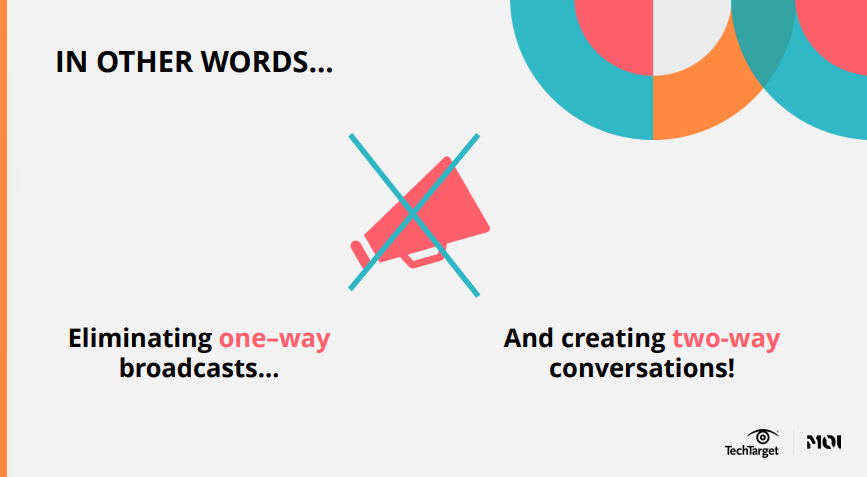 Face-to-face interactions in B2B sales and marketing are declining and digital messaging is getting ever noisier. 83% of prospects say they receive more online messages from IT vendors now than in 2020. In addition, based on the TechTarget 2021 Media Consumption report, 58% of IT professionals say they will go to fewer or no in-person events this year.
Face-to-face interactions in B2B sales and marketing are declining and digital messaging is getting ever noisier. 83% of prospects say they receive more online messages from IT vendors now than in 2020. In addition, based on the TechTarget 2021 Media Consumption report, 58% of IT professionals say they will go to fewer or no in-person events this year.
Plus, buyer perceptions and IT budgets indicate that this move to more digital outreach is a long-lasting change to the enterprise tech market.
But conversations are essential in the B2B buyer journey and there is a risk that, by shifting to an almost exclusively digital buyer journey, we lose the advantages of personal interactions and the opportunities for prospects and customers to ask direct questions and get direct responses.
As a result, marketing needs to rethink digital campaigns and find ways to stand out by emulating the success of face-to-face interactions with customers. This new way of thinking is what we call “Conversation Engine Thinking.”
How can you master this communication style and stand out in this changing market? Below are tips to help integrate this way of thinking into your campaigns and outreach.
Keeping A Human Touch in a Digital World
The human touch has the advantage of being a personalized interaction where you discover important details about the prospect and they can ask direct questions of you as a vendor. This is hard, but not impossible, to replicate online.
While respondents for our Media Consumption Report say that they are receiving larger waves of emails, social media outreach, and calls from technology vendors, this isn’t making it easier for them to buy.

The result of the usual bland and rarely personalized content is a space where prospects and customers make decisions based mainly on product features, value for money, and security but find after-sales services and vendor brands forgettable and have no problem switching vendors when it suits them.
Marketers need to start digging deep into the needs of accounts so the content they serve is hyper-relevant – not just to a broad market or persona, but at an individual or account level. This will make your brand more memorable by helping buyers progress through the buyer journey faster with fewer information roadblocks.

While live events won’t go away, their importance is diminished as we advance. In order to help buyers make the decision to choose your solution over your competitors’, you will need to:
- Provide more and better information to them online
- Create digital experiences that help buyers justify IT purchases with less direct human contact
- Personalise content according to buyers’ needs
Conversational Content Marketing: An engine for your brand
So can we make sense of this messy reality?
Enter ‘Conversation Engine Thinking’.
‘Conversation engine thinking’ is about digitally recreating the ability to converse with our prospects and customers. It’s shifting from ‘content marketing’ to ‘conversational content marketing’. It’s made up of self-serve experiences that aim to replicate the fluidity, personalization, and contextualization of an in-person meeting.
If you can do this, you have an enormous advantage over most of your competitors.
We borrowed this term from the design of chatbots that use machine learning to interact with users in context-sensitive ways. The starting point, if you choose to adopt this way of thinking, begins with two questions:
- What do you know about a specific user?
- What are they telling you about what they need?
A marketing campaign that is built upon discovering answers to these questions is the beginning of being able to have conversations on a digital marketing journey. Otherwise, you are deprived of context-aware opportunities to engage customers and prospects.
Most content marketing tends to be uni-directional (i.e. you provide value to your customer or prospect). Making your marketing conversational means you have to find ways for your customer or prospect to reply to you if they want and are ready to. You also need to learn and adapt your marketing campaign in response to that reply to increase the value you offer them.

How to Get Started with Conversational Content Marketing
Now that you understand what’s needed, what actionable steps can you take to get started?
Here are five steps that will help you get started with conversational content marketing:
1. Start with Your Desired Business Outcome
What do you want to get out of this process? It’s easier to get the results you want when you start with your end goals and work backwards.
And you want to be specific: personalising your messaging and sales outreach for a set of accounts or finding ways to break through with an account that is hesitant to make a purchase could be good examples.
You want tangible, measurable results that make sense within your existing sales and marketing strategy.
2. Audit for Listening Points in Your Buyer Journey
To succeed with conversational content marketing, you need to be looking for points in your buyer journey where customers and prospects are already trying to tell you things.
Audit your buyer journey and content strategy for where you can insert listening points and gather first-party data. Your powerful personalization will come from owning your first-party data.
Where can you insert a quiz to gather personalized information and then offer immediate value in return through a personalized report? Or perhaps you can insert a live chat option at a particular point in the research journey to help buyers quickly check requirements off their list of needs.
3. Sales and Marketing Need to Be Aligned
It is essential that sales and marketing are sharing first-party data with each other and how you can be using those insights, like the topics that prospects are signalling interest in, to engage more personally with accounts.
But this alone isn’t enough. Given the need for greater relevancy and market differentiation, it is not sufficient for this alignment to simply generate more leads. Priority should be given to accounts and prospects that can convert right now.
Additionally, you can facilitate this with tools like Priority Engine. Tools like these help you understand what your audience is reading and what topics they are researching and when. This allows you to build and distribute content personalised to individuals and companies who are actively researching your solutions. This removes the need to broadly target whole market segments and lets you get granular through tracking prospect-level intent.
4. Start with Easy Wins
There is no need to make radical changes or use untested ideas to make conversational content marketing work. Many of the best tools for this are well known but underutilised. This includes:
- Using 1st-party or 3rd-party intent data to improve the relevance of your campaigns.
- Integrating marketing tools that encourage or actively invite your customers and prospects to tell you about themselves, including:
- Quizzes and scorecards
- Diagnostic tools
- Chatbots
- Dynamic content recommendations
- ROI/TCO calculators
Additionally, make sure, whenever possible, that you are recording both the insights you collect within your customer relationship management (CRM) platform and your intent data platform like Priority Engine. This will help you notice opportunities to give personalised offerings back when your audience tells you about themselves.
5. Design an Ideal State for Conversational Content Marketing
This is a roadmap exercise that should be looking at creating space within your sales and marketing efforts that are ideal for this kind of content marketing. Start by reviewing what content you have, then look for what you need to add and what information you need to improve your content relevance.
Ask yourself and your content marketing team:
- What content do we have?
- How do we supplement this?
- What do we need to build?
- What is our current content telling our market?
- What information do we need to know to supplement that content?
This, again, doesn’t need to be an enormous undertaking. Taking small steps and making incremental changes that fill gaps in your campaign efforts is an excellent starting point.
Learn More
For more tips and insights on improving your sales and marketing outreach with Conversation Thinking, watch the full webinar ‘REFOCUS Your Digital: How to Harness ‘Conversation Engine Thinking’.
This blog provides unique perspectives and expertise based on our direct experiences within the EMEA market and is designed to be a resource for marketers targeting or working directly within this market.



